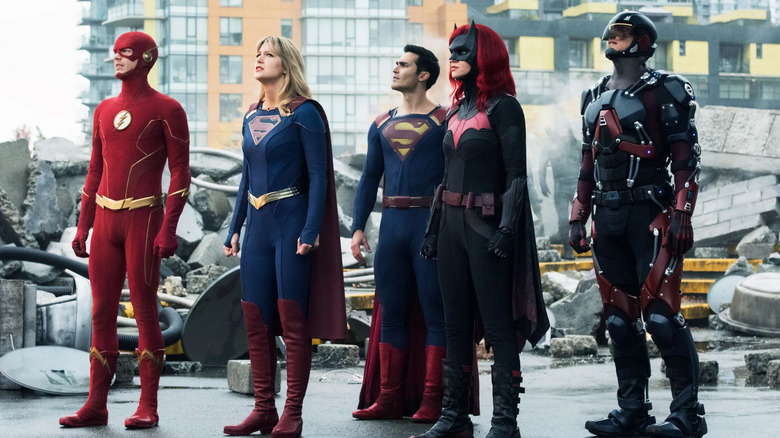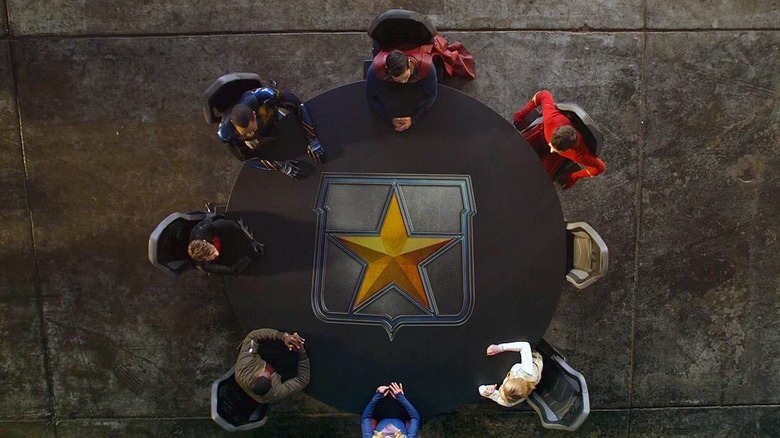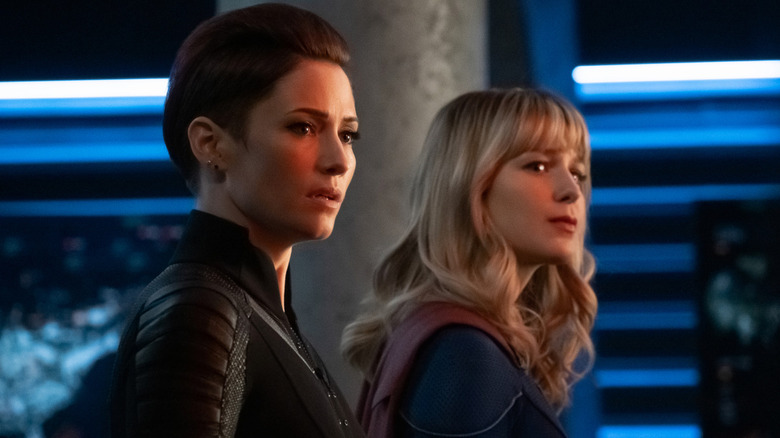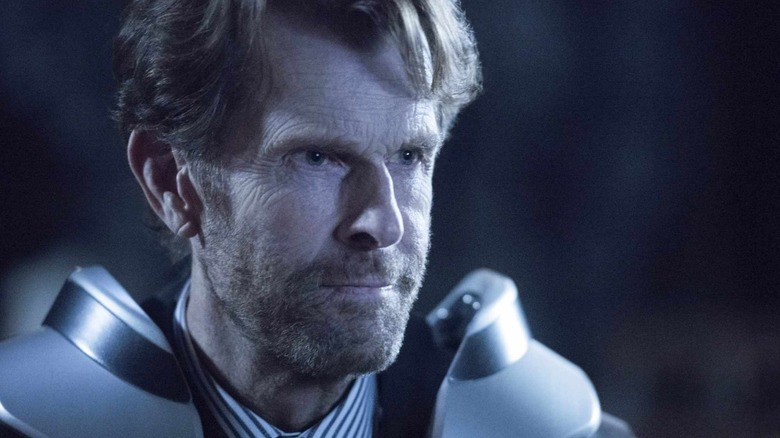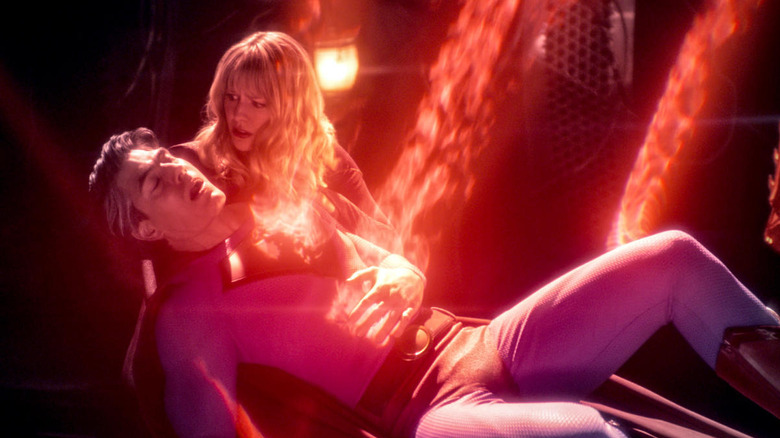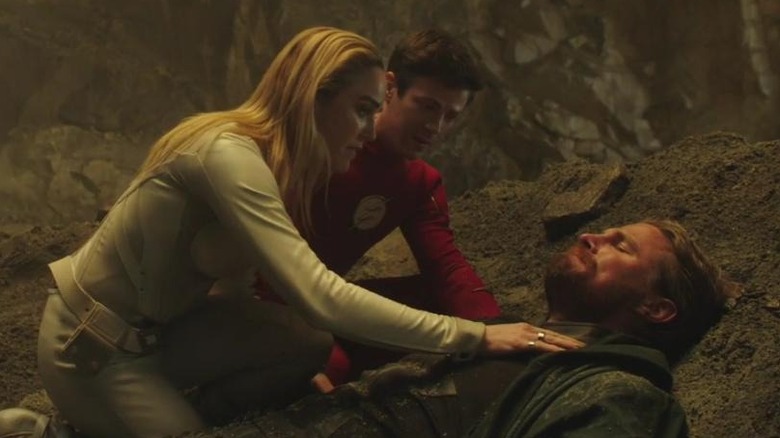Crisis On Infinite Earths Episodes In Order: How To Watch The Arrowverse Crossover
Before Marvel's Disney+ shows, and way before the DC Universe dared to combine its movies and TV series into one singular continuity, The CW's Arrowverse made TV history. More than a decade after it started, the Arrowverse remains a fantastic example of how to organically grow a shared universe. Starting with the more grounded "Arrow," the property slowly introduced more fantastical comic book-y elements with "The Flash" on its way to becoming a multiversal epic with dozens of heroes.
The yearly crossovers, in particular, were one of the best things about the Arrowverse, telling bold, high-stakes, and otherwise complex blockbuster-sized stories that felt like reading major comic book events. And without a doubt, the biggest of these was "Crisis on Infinite Earths," an adaptation of perhaps the biggest DC Comics event of all time.
Because "Crisis on Infinite Earths" combines several TV shows, and not all of them started their seasons at the same time, it can be hard to know exactly how to tackle this crossover (unless you're game to watch every single Arrowverse show in the exact order they initially aired on TV, that is). But if you're only interested in watching this particular event rather than hundreds upon hundreds of hours of television, fret not, because this is the correct order to watch "Crisis on Infinite Earths" in:
-
"Supergirl" — Season 5, Episode 9: "Crisis on Infinite Earths: Part One"
-
"Batwoman" — Season 1, Episode 9: "Crisis on Infinite Earths: Part Two"
-
"The Flash" — Season 6, Episode 9: "Crisis on Infinite Earths: Part Three"
-
"Arrow" — Season 8, Episode 8: "Crisis on Infinite Earths: Part Four"
-
"Legends of Tomorrow" — Season 5, Special Episode (before the official start of the season): "Crisis on Infinite Earths: Part Five"
There's only one way to experience Crisis on Infinite Earths
Though the Arrowverse shows are largely unconnected the vast majority of the time and can be enjoyed in whichever order you want to watch them, you'll need to check out crossovers like "Crisis on Infinite Earths" in a specific order or else its plot will make no sense. That's because its episodes form a coherent narrative split in five parts and spread across the five shows that comprised the Arrowverse at the time.
Similarly, while you can watch "Crisis on Infinite Earths" without watching anything else from the Arrowverse, it's worth knowing that the crossover was a long time in the making. As such, it continues plot threads from the previous crossover, "Elseworlds" (which introduced LaMonica Garrett as Mar Novu aka Monitor), as well as storylines from "Arrow" season 8 and much of "The Flash" season 6 (which built up to the impending crisis that threatens the entire multiverse).
Hence, when it comes to "Crisis on Infinite Earths," there's really only one way to properly experience it. With that in mind, let's break down the event's individual chapters.
Part One - Supergirl
It all begins in "Supergirl," where we see the sky turn red in several different universes — including the one from "Titans," and even the Tim Burton "Batman" movies — as they are consumed by an anti-matter wave. In response, Harbinger (Audrey Marie Anderson), a former A.R.G.U.S. agent who now serves the Monitor, brings the heroes Barry Allen aka The Flash (Grant Gustin), Kate Kane aka Batwoman (Ruby Rose), Oliver Queen aka Green Arrow (Stephen Amell), Mia Smoak aka Blackstar (Katherine McNamara), Sara Lance aka White Canary (Caity Lotz) and Ray Palmer aka The Atom (Brandon Routh) to Earth-38 to assist Kara Danvers aka Supergirl (Melissa Benoist) in the incoming crisis.
There's simply no other place to start watching "Crisis on Infinite Earths," as this is the episode that establishes what's at stake, how the multiverse begins to die, and how a team is assembled to save it all. It's also the chapter that marks the beginning of the end for Oliver Queen, who's prophesied to die before he alters the manner of his death by helping evacuate people from Earth-38 prior to its destruction.
Part Two - Batwoman
If "Part One" of "Crisis on Infinite Earths" is where the table setting happens, then "Part Two" is where the promise of a big, epic, multiversal crossover is fulfilled with an array of shocking special appearances on par with the best Marvel Cinematic Universe cameos. Indeed, this episode not only features Brandon Routh's Superman from "Superman Returns," it also includes an unexpected scene where "Smallville" veteran Tom Welling plays a Clark Kent who's given up the mantle of Superman.
Most interesting of all, this episode marks the only time the late Kevin Conroy played Bruce Wayne in live-action. The revered Batman voice actor shows up here as an aged Bruce Wayne whose look was clearly inspired by the iteration of the character from the comic book "Kingdom Come," complete with an exoskeleton.
Plot-wise, this is also the episode where we're introduced to the idea of the seven Paragons, i.e. beings that are capable of stopping Crisis and defeating the Anti-Monitor. So, again, it's best to watch the episode in order so as to not spoil this particular storyline.
Part Three - The Flash
For comic book fans, "Part Three" of "Crisis on Infinite Earths" is simply a massive treat. This is the episode that contains the most references to iconic moments from the original comic book crossover event — particularly a Flash sacrificing himself and the death of a Kryptonian.
Of course, this episode doesn't merely recreate its source material's iconography. Instead, it re-imagines it to better suit the Arrowverse, which often results in characters swapping roles from the ones they played in the original comic. Oh, and in case you were concerned that the cameos would stop after the last episode, it's worth noting that this is where Tom Ellis reprises his role as Lucifer Morningstar, the Ruler of Hell and star of the Fox (and, later, Netflix) series "Lucifer."
Above all else, this episode marks a turning point for the crossover event, in the process setting the stage for the grand finale. Thus, it bears repeating once more: Stick the release order, lest you ruin the surprises ahead of time.
Part Four - Arrow
The Arrowverse began with Oliver Queen, so it's only fitting that he would be at the center of its transformation in "Part Four" of "Crisis on Infinite Earths." That the franchise was also able to adapt DC Comics' biggest crossover event without featuring the DC Trinity (not really) and make it both coherent and exciting is a feat comparable to the MCU making Iron Man its heart and soul. Still, this episode shows just how much the Arrowverse had evolved over the years, having started with a guy who shoots arrows only for Oliver to ultimately become the Spectre (a weird and powerful DC superhero who absolutely deserves his own movie).
"Part Four" is undoubtedly the emotional climax of the "Crisis on Infinite Earths" crossover, and it needs the build up from the previous three episodes to work, so that's all the more reason to watch the previous chapters before jumping into this one. If Oliver's fate wasn't enough, this is also where we get an origin story for the Anti-Monitor, setting the stage for the grand finale.
Part Five - Legends of Tomorrow
"Worlds will live, worlds will die, and nothing will ever be the same." That's how the original "Crisis on Infinite Earths" comic book event was advertised, promising a then-unprecedented revamp of the entire DC Comics universe. "Part Five" of "Crisis on Infinite Earths" does the same thing for the Arrowverse, in the process soft rebooting the franchise at large.
Along the way, this episode also gives us one of the best takes on Lex Luthor (courtesy of Jon Cryer), some heartfelt goodbyes, and a strange new world full of heroes and villains — a rebirth of sorts. Unfortunately, the Arrowverse began retracting shortly after this crossover, so we never got to see its various characters interacting on a newly-formed Earth-Prime. Still, at least "Crisis on Infinite Earths" comes to an exciting, action-packed conclusion, complete with a grand-scale battle with the Anti-Monitor and the formation of a brand new super-team.
Altogether, "Crisis on Infinite Earths" makes for a blockbuster-sized epic — one that covers not just the Arrowverse but virtually the entire history of DC Comics adaptations on the big and small screen alike. It's a lovely tribute to these characters and this world, and nothing has been the same since.
